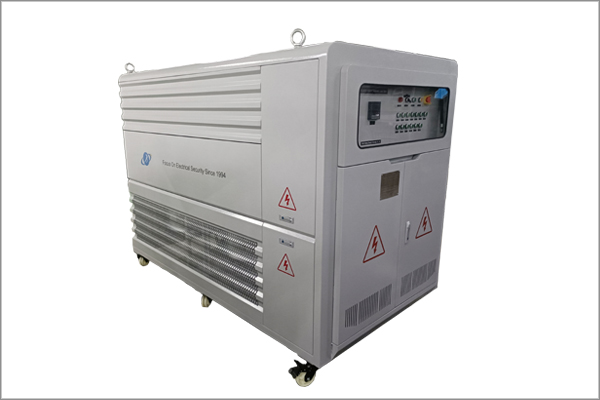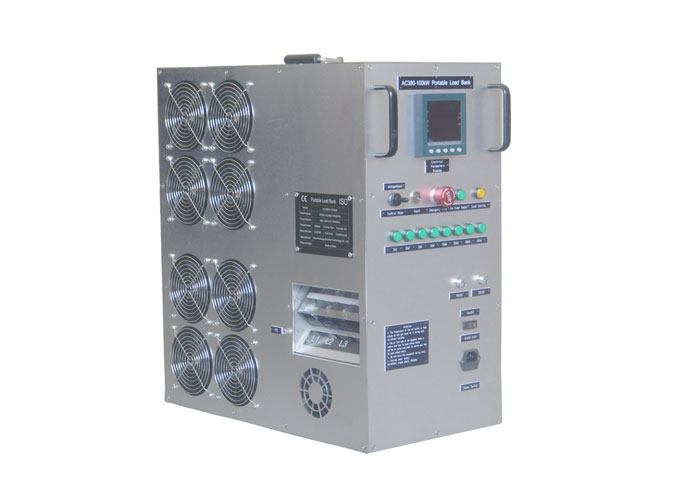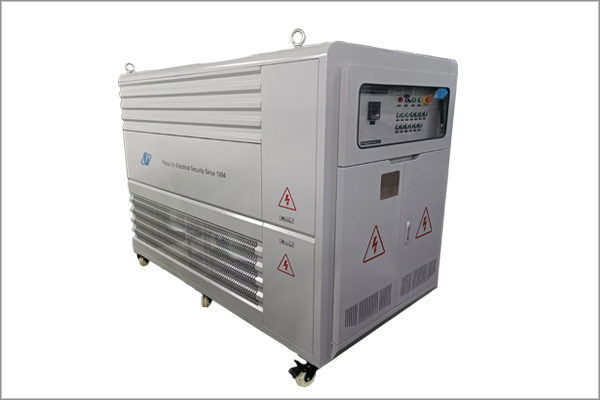The difference between resistive load bank and capacitive load bank
Time:2025-06-13
In the field of power electronics, the load bank is an important device used to simulate the load characteristics of circuits. According to the differences in their working principles and load characteristics, they can be divided into resistive load bank and capacitive load bank. These two devices play different roles in the circuit. The following will elaborate on their differences in detail from multiple key aspects.
I. Basic Working Principle
(1) Resistive load bank
Resistive load bank are mainly composed of resistive components, and their working principle is based on Ohm's Law. When current passes through a resistor, electrical energy is converted into thermal energy. The hindrance effect of the resistor on the current does not change with the frequency and phase of the current. In a circuit, the current and voltage phases of a resistive load are the same, that is, the power factor is 1. This characteristic enables the resistive load bank to have high accuracy when simulating pure resistive loads.
(2) Capacitive load bank
The capacitive load bank is mainly composed of capacitive components, and its working principle is closely related to the charging and discharging characteristics of the capacitors. A capacitor has the ability to store electric charge in a circuit. When a voltage is applied, the capacitor will charge. When the voltage changes, the capacitor will discharge. In an alternating current circuit, the current phase of a capacitive load leads the voltage phase, and the power factor is less than 1. The capacitive load bank precisely utilizes this characteristic of capacitors to simulate the capacitive load in the circuit.
Ii. Impact on Circuits
(1) Resistive load bank
The relationship between voltage and current: Since the current and voltage of a resistive load have the same phase, in a circuit, a resistive load bank will not cause a phase difference between voltage and current. When a resistive load bank is connected, the voltage and current in the circuit will change proportionally according to Ohm's Law, and no reactive power will be generated.
Power consumption: The resistive load bank mainly consumes active power, and the power it consumes is equal to the square of the current multiplied by the resistance value. In circuits, resistive load bank convert all electrical energy into thermal energy. Therefore, in some energy-consuming situations, such as heating equipment and power testing, resistive load bank have been widely applied.
(2) Capacitive load bank
The relationship between voltage and current: The current phase of a capacitive load leads the voltage phase. Therefore, when a capacitive load bank is connected, it will cause the current phase in the circuit to lead the voltage phase, generating reactive power. This phase difference can affect other components in the circuit, such as transformers and generators, and may lead to a decrease in their capacity utilization.
Power consumption: The power consumed by the capacitive load bank is mainly reactive power, while the consumption of active power is very small. In the circuit, the capacitive load bank will feed back reactive power to the power supply, thereby affecting the power factor of the power supply. To improve the power factor of the power supply, it is usually necessary to parallel inductive loads in the circuit to compensate for the reactive power generated by capacitive loads.
Iii. Application Scenarios
(1) Resistive load bank
Power equipment testing: During the research and development, production and commissioning of power equipment, various load tests need to be conducted on the equipment, such as generators, transformers, circuit breakers, etc. Resistive load bank can simulate pure resistive loads and are used to test the performance and stability of equipment under different load conditions.
Heating equipment: As the resistive load bank converts all electrical energy into thermal energy, it can be used as a heating element in some situations that require heating, such as industrial heating and home heating.
Power measurement: In power measurement, resistive load bank can be used as standard loads to calibrate power measurement instruments and enhance measurement accuracy.
(2) Capacitive load bank
Reactive power compensation in power systems: In power systems, due to the existence of a large number of inductive loads, such as motors and transformers, the power factor of the system will decrease. The capacitive load bank can be used as a reactive power compensation device to feed back reactive power to the system, improve the power factor of the system and reduce line losses.
Electronic device testing: In the testing of electronic devices such as power supplies and filters, it is necessary to simulate different load characteristics. Capacitive load bank can be used to simulate capacitive loads and test the performance and stability of equipment under capacitive load conditions.
High-frequency circuits: In high-frequency circuits, the capacitive reactance of capacitors decreases as the frequency increases. Therefore, capacitive load banks have better adaptability in high-frequency circuits. For instance, in a radio transmitter, a capacitive load bank can be used to match the impedance of the antenna and the transmitter, thereby enhancing the transmission efficiency.
Iv. Structure and Composition
(1) Resistive load bank
The structure of a resistive load bank is relatively simple, mainly consisting of resistive components, heat dissipation devices, control circuits and a casing, etc. Resistance components typically adopt wired-wound resistors, metal film resistors or cement resistors, etc., which have high power carrying capacity and stability. The heat dissipation device is used to dissipate the heat generated by the resistance components to ensure the normal operation of the equipment. The control circuit is used to adjust the size of the load and control the operating status of the equipment.
(2) Capacitive load bank
The structure of a capacitive load bank is relatively complex, mainly consisting of capacitive components, reactors, control circuits and a casing, etc. Capacitive components usually adopt oil-immersed capacitors or film capacitors, etc., which have high withstand voltage values and capacity stability. Reactors are used to limit the charging current of capacitors to prevent excessive current from causing damage to the equipment. The control circuit is used to adjust the size of the load and control the operating status of the equipment. At the same time, it also needs to have functions such as overvoltage and overcurrent protection.
V. Selection and Usage Precautions
(1) Resistive load bank
Power selection: When choosing a resistive load bank, the power capacity of the load bank should be determined based on the maximum power of the circuit. If the power capacity of the load box is too small, it will cause the equipment to overheat and get damaged. If the power capacity is too large, it will cause waste.
Resistance value selection: The selection of resistance value needs to be determined based on the voltage and current of the circuit. When choosing the resistance value, it is necessary to ensure that the resistance value of the load bank matches the circuit to guarantee the accuracy of the test results.
Heat dissipation conditions: As the resistive load bank generates a large amount of heat during operation, it is necessary to ensure that the equipment has good heat dissipation conditions. When installing the load box, sufficient space should be reserved to facilitate air circulation and reduce the temperature of the equipment.
(2) Capacitive load bank
Capacity selection: When choosing a capacitive load bank, the capacity of the load bank should be determined based on the reactive power demand of the circuit. If the capacity is too small, it cannot meet the requirements of reactive power compensation. If the capacity is too large, it will cause the system voltage to rise, affecting the normal operation of the equipment.
Selection of withstand voltage value: The withstand voltage value of capacitor components needs to be determined based on the operating voltage of the circuit. When choosing the withstand voltage value, it is necessary to ensure that the withstand voltage value of the capacitor component is higher than the working voltage of the circuit to prevent the capacitor from being damaged due to breakdown.
Safety protection: Capacitive load banks store a large amount of charge during operation, so they need to have comprehensive safety protection measures. For instance, overvoltage and overcurrent protection devices need to be installed at the input and output ends of the load bank to prevent harm to personnel and equipment in case of equipment failure.
In conclusion, there are obvious differences between resistive load bank and capacitive load bank in terms of basic working principles, their impact on circuits, application scenarios, structures and compositions, as well as selection and usage precautions. In practical applications, it is necessary to select the appropriate load bank based on specific requirements and circuit characteristics to ensure the normal operation of the equipment and the accuracy of the test results.
News Recommendation
-
 2024-09-11
2024-09-11TRIUMPH LOAD EXHIBITING AT Enlit Europe 2024 -BOOTH 7.H08
-
 2023-04-21
2023-04-21TRIUMPH LOAD EXHIBITING AT DATA CENTER WORLD GERMANY 2023-BOOTH F909
-
 2023-04-06
2023-04-06TRIUMPH LOAD EXHIBITING AT ELECTRIC POWER TECH KOREA 2023 – Booth G109
-
 2022-05-05
2022-05-05What is the role of ac load bank for power supply?
-
 2022-05-05
2022-05-05What is the role of the load bank?


